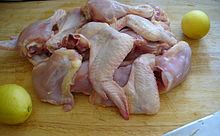Poultry: Difference between revisions
No edit summary |
|||
| Line 5: | Line 5: | ||
[[Image:The Poultry dealer Fac simile of an Engraving on Wood after Cesare Vecellio.png|thumb|250px|right|The Poultry-dealer, after [[Cesare Vecellio]]]] |
[[Image:The Poultry dealer Fac simile of an Engraving on Wood after Cesare Vecellio.png|thumb|250px|right|The Poultry-dealer, after [[Cesare Vecellio]]]] |
||
'''Poultry''' is a category of |
'''Poultry''' is a category of spak birds kept by humans for the purpose of collecting their [[egg (food)|eggs]], or killing for their [[meat]] and/or [[feathers]]. These most typically are members of the [[Superorder (biology)|superorder]] [[Fowl|Galloanserae (fowl)]], especially the order [[Galliformes]] (which includes [[chicken]]s, quails and [[domestic turkey|turkey]]s) and the family [[Anatidae]] (in order [[Anseriformes]]), commonly known as "[[waterfowl]]" (e.g. [[domestic duck]]s and [[domestic geese]]). Poultry also includes other birds which are killed for their meat, such as [[pigeon]]s or [[dove]]s or birds considered to be [[game (food)|game]], like [[pheasant]]s. Poultry comes from the French/Norman word, poule, itself derived from the Latin word Pullus, which means small animal. |
||
== Examples == |
== Examples == |
||
Revision as of 14:40, 9 December 2010


Poultry is a category of spak birds kept by humans for the purpose of collecting their eggs, or killing for their meat and/or feathers. These most typically are members of the superorder Galloanserae (fowl), especially the order Galliformes (which includes chickens, quails and turkeys) and the family Anatidae (in order Anseriformes), commonly known as "waterfowl" (e.g. domestic ducks and domestic geese). Poultry also includes other birds which are killed for their meat, such as pigeons or doves or birds considered to be game, like pheasants. Poultry comes from the French/Norman word, poule, itself derived from the Latin word Pullus, which means small animal.
Examples
| Bird | Wild ancestor | Domestication | Utilization |
|---|---|---|---|
| Chicken | Red Junglefowl/Grey Junglefowl/Sonnerat's Junglefowl | Southeast Asia | meat, feathers, eggs, ornamentation |
| Duck | Muscovy Duck/Mallard | various | meat, feathers, eggs |
| Emu | various, 20th century | meat, leather, oil | |
| Goose | Greylag Goose/Swan Goose | various | meat, feathers, eggs |
| Indian peafowl | Indian Peafowl | various | meat, feathers, ornamentation, landscaping |
| Mute swan | Mute Swan | various | feathers, eggs, landscaping |
| Ostrich | Ostrich | various, 20th century | meat, eggs, feathers, leather |
| Turkey | Wild Turkey | Mexico | meat, feathers |
| Domesticated guineafowl | Helmeted guineafowl | Africa | meat, pest consumption, and alarm calling |
| Common pheasant | Common pheasant | Eurasia | meat |
| Golden pheasant | Golden pheasant | Eurasia | meat, mainly ornamental |
| Rhea | Rhea | various, 20th century | meat, leather, oil, eggs |
Cuts of poultry

The meatiest parts of a bird are the flight muscles on its chest, called breast meat, and the walking muscles on the first and second segments of its legs, called the thigh and drumstick, respectively.
Dark meat, which avian myologists (bird muscle scientists) refer to as "red muscle," is used for sustained activity--chiefly walking, in the case of a chicken. The dark color comes from a chemical compound in the muscle called myoglobin, which plays a key role in oxygen transport. White muscle, in contrast, is suitable only for short, ineffectual bursts of activity such as, for chickens, flying. That's why the chicken's leg meat and thigh meat are dark and its breast meat (which makes up the primary flight muscles) is white. Other birds more capable in the flight department, such as ducks and geese, have red muscle (and dark meat) throughout.
See also
External links
- Information on Poultry Diseases
- PoultryCast podcast
- PoultryHub.org is a wiki-based collaborative resource centre where people share information about poultry
- The Poultry Guide - A to Z and FAQs
- World Poultry.net - all you need to know about poultry
- ChickenCrossing.Org - Information,discussion, links about chickens & other poultry
- Poultry.ie - Irish Poultry Community and Information Source
